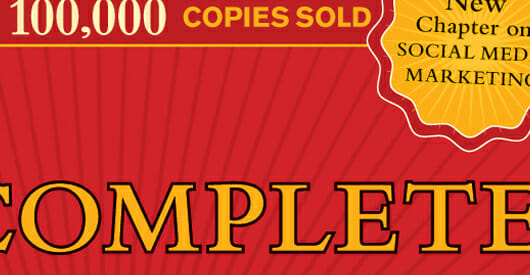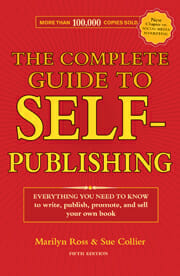
In the early days of modern self-publishing, there were two books most self-publishers lived by: The Self-Publishing Manual by Dan Poynter, and The Complete Guide to Self-Publishing by Marilyn and Tom Ross.
While Poynter has continued to update his book, now in its 15th edition, The Complete Guide was sorely in need of an overhaul.
Now, since Sue Collier has joined Marilyn Ross as the new owner of Self-Publishing Resources, the company Marilyn and Tom founded, Sue brings the modern sensibilities of a blogger and active social media user to the company. (You can connect with Sue at: @SueCollier.)
Sue has taken on the herculean task to bring the massive Complete Guide into the twenty-first century. And she’s done about as well as could be expected.
The Whole Nine Yards of Self-Publishing
The approach of The Complete Guide to Self-Publishing is encyclopedic. It attempts to cover just about every base you might cross as a self-publisher.
The book is divided into seven parts:
-
- PART I: Today’s Publishing Scene—Deals with the history of self-publishing, different ways to get into print, the difference between subsidy, vanity and self-publishing, goal-setting, and an overview of the ebook market.
- PART II: Start-Up Considerations to Get You Off on the Right Foot—This part discusses finding subjects to write about, the nuts and bolts of researching and writing books, different sorts of books you can publish, editing, setting up your publishing company, generating capital, operating procedures, bookkeeping, tax implications, choosing publication dates, getting ISBNs and bar codes, and the other minutia of publishing.
- PART III: Creating a Quality Product That Attracts Buyers—The authors delve into book design and production.
- PART IV: Killer PR—The Great Equalizer—The Rosses were always known for national campaigns, and that emphasis continues here, with a strong section on PR, marketing plans, reviews, getting editorial coverage, generating radio and TV interviews, running book signings and the like.
- PART V: Selling Books the Usual Ways—The authors explain how to get into the retail book distribution channel in order to sell to bookstores, about wholesalers and distributors, and the ins and outs of advertising and direct mail, subsidiary rights and book spin-offs.
- PART VI: Nontraditional Venues for Generating More Sales—Here you’ll find a new section on social media marketing, premiums and incentives, and other “maverick” sales opportunities. Also discussions of developing a sideline as a speaker, creating seminars and working trade shows and book fairs.
- PART VII: Propelling Your Business Through the Stratosphere—Looks at different ways to expand, either through selling your book to a traditional publisher, or by transforming into a small press.

Amazon affiliate linkclick to order
The book concludes with a brief timetable, the outline of a five-month marketing plan, and lots of resource lists. There’s a bibliography, a glossary and an index, which you will find useful.
What’s the Bottom Line on The Complete Guide to Self-Publishing?
I’m really glad Sue Collier has updated this book, which has been fantastically useful to generations of self-publishers. With the addition of a lot of web-oriented material, the book should have another useful lifespan. It’s also been completely redesigned and has a much more modern appearance.
One thing I liked were the “Websites, Wisdom & Whimsy” sections at the end of each chapter. These are set apart through some fanciful typography, and have amusing quotes, tips and resources. They even included one of my all-time favorite William Safire quotes: (Safire wrote a column on language for the New York Times for many years.)
William Safire was asked if sloppy communication was caused by ignorance or apathy. “I don’t know and I don’t care,” he quipped.
The scope of this book is very similar to Poynter’s but it’s written quite differently. It continues to show its parentage as the original product of Tom and Marilyn Ross who worked together to establish a highly successful company in the publishing business.
This is also one of its shortcomings. Despite being overhauled, there’s no way this book can escape the era in which it was written. The entire mindset of the book is oriented to traditional self-publishing using offset printers, wholesalers, distributors and sales through the whole chain of distribution.
Today creating anything like a national campaign for a self-published book is very difficult task, and one that almost all self-publishers would fail at. Tough but true. On the other hand, the explosion in self-publishing brought about by print on demand technology and now, by ebooks, is given little attention as a viable commercial model.
Yet in my experience this is the path being taken by an increasing number of self-publishers, in response to technological changes, risk-aversion brought on by the economic collapse, and the ability to put a book into print for almost no money. When The Complete Guide was originally issued, self-publishing relied on your ability to sell at least 2,000 offset books just to pay for your development costs. This is no longer true.
On the whole however, this is a valuable book for people entering self-publishing. It gives a thorough overview of how the different pieces of the puzzle fit together, and has plenty of illustrations, forms, resource links to point you in the right direction. It’s practical throughout and will be endlessly useful as a reference as you go through the process of becoming a self-publisher.
Oh, Um, There’s This One More Thing . . .
Tom and Marilyn Ross always expemplified the proud and outspoken spirit of self-publishers, and they championed other self-publishers and helped to make them a success. So it’s a little ironic that The Complete Guide to Self-Publishing is no longer self-published. This new edition is being published by Writers Digest. Which is interesting. In November Writers Digest will also publish the formerly-self-published Indie Author by indie publishing advocate April L. Hamilton, who has written about her decision to traditionally publish her book.
Both of these books are high-quality, must-read acquisitions for modern self-publishers, and I hope they both sell a lot of books. The self-publishing world would be better for it.
Takeaway: Although showing its origins, The Complete Guide to Self-Publishing is the new must-have book for people who want to self-publish, and a tribute to Sue Collier’s diligence. I recommend it.
The Complete Guide to Self-Publishing
Paperback: 576 pages
Publisher: Writers Digest Books; 5th edition
Publication date: August 9, 2010 (but on sale now)
ISBN-13: 978-1582977188


